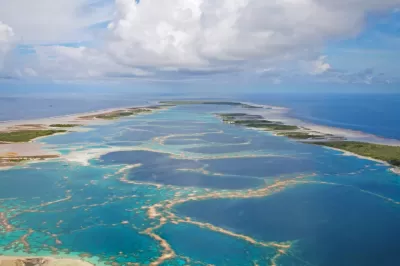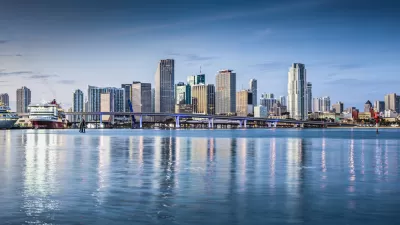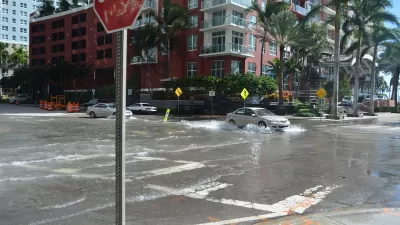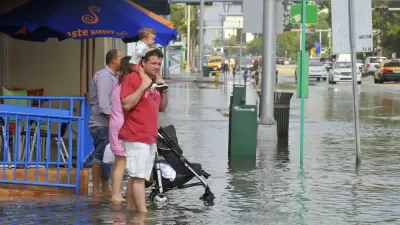As the climate warms, the world's glaciers and ice sheets are melting, but sea level increase will be greater in some places due to the earth's rotation and gravity, according to a newly released study by the NASA Jet Propulsion Laboratory.

How much can you expect rising sea levels to threaten your coastal city? The answer lies in part in knowing which glacial ice melts affect it, so planners can determine how much of an increase to prepare for.
"NASA's Jet Propulsion Lab has mapped how changes in these giant ice fields influence sea levels both nearby and thousands of miles away," reports Christopher Joyce, science correspondent for NPR (audio available). "They published their results in the journal Science Advances."
It turns out that in New York City, the sea level would be affected more by melting ice on the northern end of Greenland than much closer ice in southern Greenland, or even ice in Canada.
Scientists are now using this information to predict the future for American cities, but they're also building in a lot of local geographical information.
"The National Oceanic and Atmospheric Administration (NOAA) is putting together a sea level rise grid for the country, one that will factor in local conditions as well as the effects of faraway melting ice," adds Joyce.
Sea level decrease?
Yes, melts in the eastern Greenland ice sheet could cause a minor drop in sea level in Norway while raising sea levels off Tokyo by several inches, writes Joyce.
============================================================================================================================
Jeff Goodell’s new book, The Water Will Come: Rising Seas, Sinking Cities, and the Remaking of the Civilized World was reviewed by Jennifer Senior for The New York Times on Nov. 22. While Joyce of NPR indicates that sea level has risen an average of eight inches over the last century, Senior writes that the authors of climate reports for the 2015 Paris agreement estimate sea level rise at over three feet by 2100.
Now many scientists believe that estimate is too low. Some say the sea could rise as much as six feet; others say even more than that.
“For anyone living in Miami Beach or South Brooklyn or Boston’s Back Bay or any other low-lying coastal neighborhood,” Goodell writes, “the difference between three feet of sea level rise by 2100 and six feet is the difference between a wet but livable city and a submerged city.”
"Of all the American cities in this book, Miami seems least equipped to handle a rise in sea level, founded as it is on pleasure, real estate and the inalienable right to not pay state income taxes," adds Senior.
FULL STORY: The Sea Level Threat To Cities Depends On Where The Ice Melts — Not Just How Fast

Trump Administration Could Effectively End Housing Voucher Program
Federal officials are eyeing major cuts to the Section 8 program that helps millions of low-income households pay rent.

Planetizen Federal Action Tracker
A weekly monitor of how Trump’s orders and actions are impacting planners and planning in America.

Ken Jennings Launches Transit Web Series
The Jeopardy champ wants you to ride public transit.

Washington Legislature Passes Rent Increase Cap
A bill that caps rent increases at 7 percent plus inflation is headed to the governor’s desk.

From Planning to Action: How LA County Is Rethinking Climate Resilience
Chief Sustainability Officer Rita Kampalath outlines the County’s shift from planning to implementation in its climate resilience efforts, emphasizing cross-departmental coordination, updated recovery strategies, and the need for flexible funding.

New Mexico Aging Department Commits to Helping Seniors Age ‘In Place’ and ‘Autonomously’ in New Draft Plan
As New Mexico’s population of seniors continues to grow, the state’s aging department is proposing expanded initiatives to help seniors maintain their autonomy while also supporting family caregivers.
Urban Design for Planners 1: Software Tools
This six-course series explores essential urban design concepts using open source software and equips planners with the tools they need to participate fully in the urban design process.
Planning for Universal Design
Learn the tools for implementing Universal Design in planning regulations.
Heyer Gruel & Associates PA
Ada County Highway District
Institute for Housing and Urban Development Studies (IHS)
City of Grandview
Harvard GSD Executive Education
Toledo-Lucas County Plan Commissions
Salt Lake City
NYU Wagner Graduate School of Public Service





























